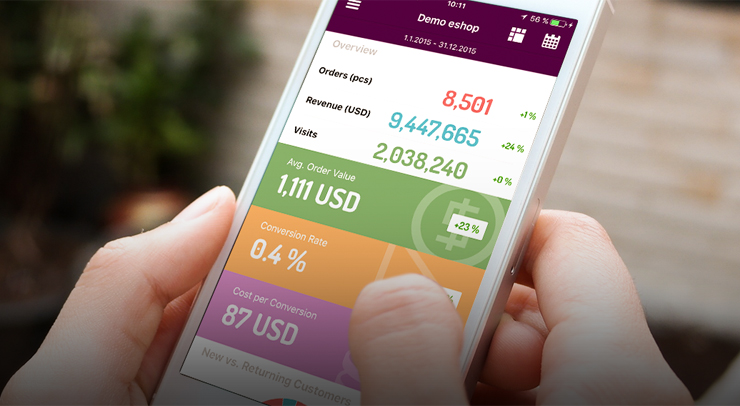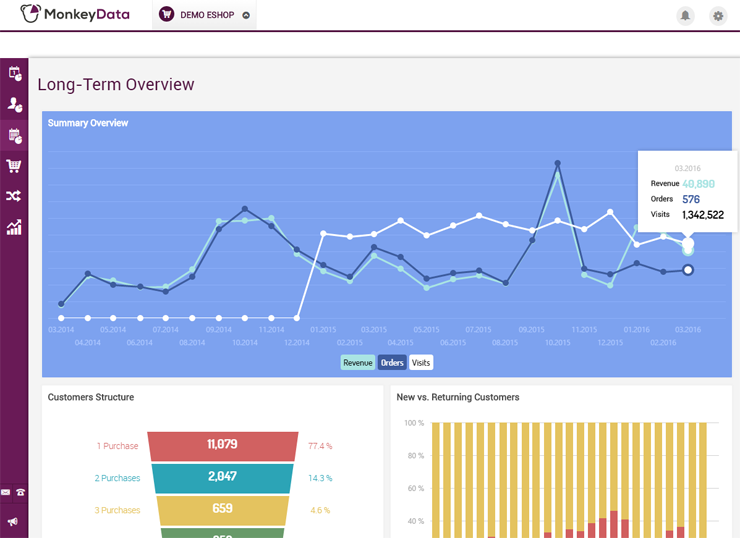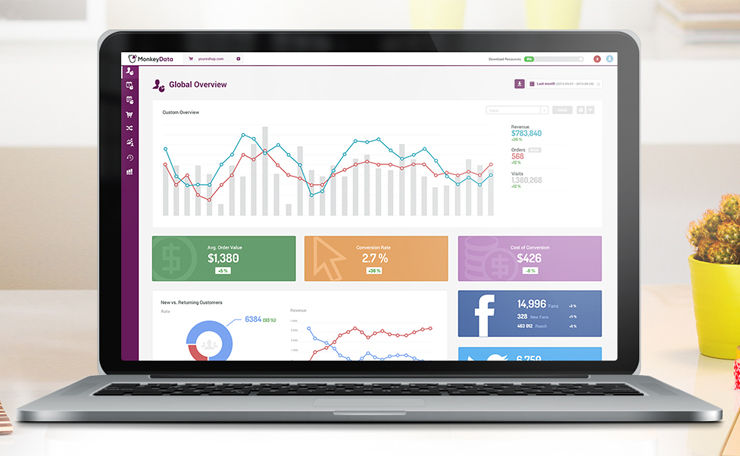MonkeyData helps ecommerce players with data analysis

Ecommerce companies can really make a difference nowadays if they use their data efficiently. But there’s data everywhere and it takes some time and effort to analyze all this. A European startup that tries to solve this problem, is MonkeyData. This Czech SaaS company analyses data from various sources and shows the results in one place in an organized dashboard. We interviewed them about data, ecommerce software and the differences between some European countries.
First of all, please explain the name to us?
Jan Laštůvka, CEO at MonkeyData: “The name was created during one of our brainstorming beer sessions. We wanted to have the word “data” in the title so that it would be clear what field we are focused on, but we also wanted to demonstrate that we do the analytics in a fun and interactive way. When people heard the word “monkey”, most of us showed a smile. We liked it and so the name MonkeyData was born.”
You now analyze data from Shopify, BigCommerce, Ecwid, OpenCart and many more. Are there any other software solutions you will analyze in the near future?
“We also included others, such as Woocommerce, which is one of the most widespread platforms in the world nowadays, together with ePages or Weebly. We will also analyze data from BigCartel and 3DCart. But apart from these global platforms, we also co-operate with many local ones. We added Dutch platform Lightspeed, Polish ecommerce platform Shoper and Czech leading ecommerce platform ShopSys. Besides that we will also offer data from payment gateways, marketplaces like Amazon and Ebay and logistic companies such as DHL and UPS. And that is definitely not the end of it!”
What do you think is the feature your customers appreciate the most?
“The biggest advantage for MonkeyData customers is that they have all the data in one place. They can easily see how their metrics are doing, allowing them more time to focus on running their business. We help them grow with us. Another big advantage is the simplicity of the connection in the spirit of our plug & analyze philosophy. The whole process takes up to 3 minutes during which no further settings are required.”

What are the most important metrics ecommerce companies should be aware of?
“When you are an online store owner, you should pay attention to metrics that are directly connected to profits and are easily accessible, either from your store or from other tools. One of the most useful metrics is cost per conversion. Many online stores use individual paid channels i.e. PPC or price comparison apps, which run based on the cost per conversion principle. These stores often use it under the pressure of competitiveness and forget about efficiency of these campaigns versus revenue. Because of this the total cost per conversion relative to revenue increases and merchants lose margins on their products. Another great metric is new vs. returning customers. A very low proportion of returning customers indicates that most of your customers chose not to make another purchase from your online store after the first one, and you should find out why. Check whether you have prices comparable with your competition, whether the delivery time takes too long, etc.”

You are very active in the global events sphere. Last year you went to ecommerce events in the Czech Republic, Ireland, Poland, the United Kingdom, Germany, Israel, China and Slovakia. What are the differences between these events/countries? Do you have to approach potential customers differently for example?
“The main difference between the US, Europe and Asia is mostly in the source of data. Every country has its own local tools, customers behave differently, the form and channel of purchase differs. Another interesting point is that nowadays more than 50 percent of customers in Asia do their shopping through mobile devices.”
Is there something MonkeyData have learned from their (foreign) customers? Something you completely didn’t think of?
“Traveling and getting to know local places showed us how people think and shop differently across continents, which affected formation of the app with respect to inputs and outputs. For example, mcommerce is strongly represented in Asia. And in Poland, people mostly buy things at online marketplaces. This is in contrast to the Czech Republic where people prefer to shop directly from an online store. Based on these experiences we adjusted our metrics and sources.”
What is your opinion on the ecommerce industry in Europe? What makes it so good and what things could be better?
“Europe is a very miscellaneous marketplace, where it’s possible to find highly developed ecommerce markets with well-established logistics, online payments, mobile purchases and an advanced form of marketing communication. Every country sets its own pace. For example, in Western Europe the mobile solution is improving and vastly increasing its market share, while in Eastern Europe they work hard on improving logistics. Southern Europe is on the enormous uptrend regarding ecommerce, with Spain in the lead. Ecommerce is also progressively growing in Eastern Europe.”

What more can we expect from mobile commerce? And why is analyzing data from mobile users so important for online retailers?
“Mobile devices have become a common part of our lives. Just as ecommerce becomes a natural channel for our shopping, mobile devices will become a natural tool for shopping as well. Currently more than 50 percent of consumers in Asia do their shopping through mobile devices. In the US and Europe this share is around 30 percent. In one year, mcommerce has risen by more than 200 percent in Asia, and given our expectations, mcommerce will represent 80 percent of all ecommerce transactions by 2020 in Asia, and more than 50 percent of ecommerce in the US and Europe. So it’s clear that it’s necessary to not underestimate the channel and to work with it.”
Is there some data our readers really should know?
“Based on reports from ecommerce studies for the previous year available from around the world, we can say that the mobile share has vastly increased, especially in the US and South America – in some stores it is up to 60%. Another interesting fact is the type of payment. Customers in the US and Western Europe use quick online payments, such as payment cards and payment gateways. But the share of payment cards and gateways rapidly decreases as we go eastward, where C.O.D. (which is, for example, very popular in the Czech Republic) and paying in advance (popular in Asia) prevail. Also, I would like to mention some interesting data about social commerce. It’s very interesting that an average of 85 percent of all ecommerce orders from social media come from Facebook. And it is Facebook again that has the highest conversion rate (1.85%) for all social media ecommerce traffic.”
So this is all very exciting, can you tell us more about MonkeyData’s future plans?
“As we love moving forward and getting closer to our customers, we recently opened a new office in Berlin. This city is known as the European Silicon Valley and we are all very excited about it. Also, we plan to expand our offices to the USA and open a branch there soon.”

Comments